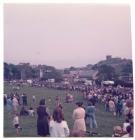Content can be downloaded for non-commercial purposes, such as for personal use or in educational resources.
For commercial purposes please contact the copyright holder directly.
Read more about the The Creative Archive Licence.
Description
Criccieth The Great Storm of 1927. At the bottom of the hill, on the eastern side of the castle, is an area called Abermarchnad which, as the name suggests, was where early markets were held. The headland of the castle gives some shelter and this is where fishing boats and small ships were beached. The River Cwrt empties into the sea here after driving the wheel of the mill, there was a shed for smoking herring and later a lime kiln was built. On an accretion of land, probably built up by clearing boulders off the beach were two or three cottages and a storehouse. In 1867 the railway arrived and the town developed as a tourist resort. William Watkins of Muriau built the Marine Terrace for the visitors in 1877 and at Abermarchnad built a block of ten houses to add to two of the original cottages, to accommodate the workers building the new resort. Fishermen and mariners also lived here. Twelve families lived in this little community at first but two of the original cottages were later demolished.
These families were to lose their homes in a tremendous storm in 1927. The depression which moved rapidly in on the 27th/28th October was not particularly low at 971mb. It was the rapid rise in pressure behind the depression, which developed a very intense pressure gradient caused by the rapid movement of the system resulting in the storm force winds. This combined with the spring tide caused a storm surge. It was obvious that there was danger to the occupants. The barometer at the Lifeboat Station and the unusual way the tide was behaving gave plenty of warning so all the families were moved to safety except for one old lady who refused to leave and hid under a table throughout the storm. At the height of the storm that evening the enormous waves brought down walls of the houses and washed out furniture and possesions. Further along the seafront the waves roared under Bont Du (The railway bridge) almost as far as the main road. After the disaster it was apparent that the houses were beyond repair so they were demolished. The families were housed with other members of their families, neighbours and at the Old Town Hall. Mrs Lewis of Talhenbont Hall gifted some land to build new houses for these unfortunate people at Henbont Road. Its difficult to imagine that the little green opposite the Blue China cafe was once a lively community.






Do you have information to add to this item? Please leave a comment
Comments (0)
You must be logged in to leave a comment